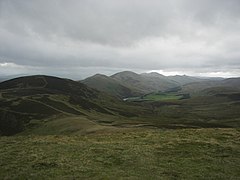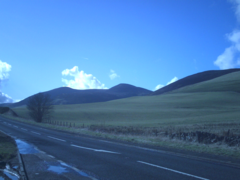
Dumfriesshire or the County of Dumfries or Shire of Dumfries is a historic county and registration county in southern Scotland. The Dumfries lieutenancy area covers a similar area to the historic county.

Great Dodd is a mountain or fell in the English Lake District. It stands on the main ridge of the Helvellyn range, a line of mountains which runs in a north–south direction between the lakes of Thirlmere and Ullswater in the east of the Lake District. Great Dodd, with a height of 857 metres (2,812 ft) is the highest of the fells in this range to the north of Sticks Pass.
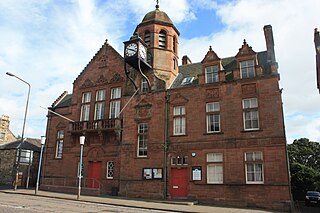
Penicuik is a town and former burgh in Midlothian, Scotland, lying on the west bank of the River North Esk. It lies on the A701 midway between Edinburgh and Peebles, east of the Pentland Hills.

The Southern Uplands are the southernmost and least populous of mainland Scotland's three major geographic areas. The term is used both to describe the geographical region and to collectively denote the various ranges of hills and mountains within this region. An overwhelmingly rural and agricultural region, the Southern Uplands are partly forested and contain many areas of open moorland - the hill names in the area are congruent with these characteristics.

The River Esk, also called the Lothian Esk, is a river that flows through Midlothian and East Lothian, Scotland.

The A702 is a major road in Scotland, that runs from Edinburgh to St. John's Town of Dalry in Dumfries and Galloway. It is the last section of the route from London via the West Midlands and North West England to Edinburgh, which follows the M1, M6, A74(M) and finally the A702.

Lasswade is a village and civil parish in Midlothian, Scotland, on the River North Esk, nine miles south of Edinburgh city centre, contiguous with Bonnyrigg and between Dalkeith to the east and Loanhead to the west. Melville Castle lies to the north east. The Gaelic form is Leas Bhaid, meaning the "clump at the fort."
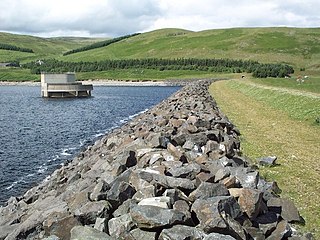
Megget Reservoir is an impounding reservoir in the Megget valley in Ettrick Forest, in the Scottish Borders. The 259 hectares reservoir is held back by the largest earth dam in Scotland. The reservoir collects water from the Tweedsmuir Hills, which is then conveyed 28 miles (45 km) via underground pipelines and tunnels to Edinburgh. The pipelines are routed through the Manor Valley and the Meldon Hills, to Gladhouse Reservoir and Glencorse Reservoir in the Pentland Hills. These two reservoirs store the water until such times as it is required. Excess water which overflows from the reservoir is returned to the Megget Water, and hence into St. Mary's Loch.

The Lomond Hills, also known outside the locality as the Paps of Fife, are a range of hills in central Scotland. They lie in western central Fife and Perth and Kinross, Scotland. At 522 metres (1,713 ft) West Lomond is the highest point in the county of Fife.
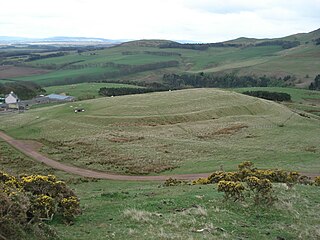
Castle Law is a hill south west of Fairmilehead in the Pentland Hills in Midlothian, Scotland.

Gladhouse Reservoir, formerly known as Moorfoot Loch, is a reservoir in Midlothian, Scotland, five miles (8 km) south of Penicuik. It is the most southerly reservoir in Midlothian, as well as being the largest area of freshwater in the Lothians. It is used to supply Edinburgh with drinking water.

The Moorfoot Hills are a range of hills south of Edinburgh in east central Scotland, one of the ranges which collectively form the Southern Uplands.
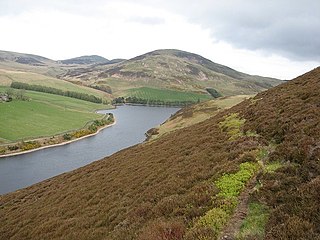
Glencorse Reservoir is a reservoir in Midlothian, Scotland, two miles west of Glencorse, in the Pentland Hills.

Glencorse Barracks is a British Army barracks situated in Glencorse just outside the town of Penicuik in Midlothian, Scotland. It is one of the three barracks which make up the City of Edinburgh Garrison, with Dreghorn and Redford Barracks. It has been the home for The Royal Highland Fusiliers, 2nd Battalion, The Royal Regiment of Scotland since 2006.
Glencorse is a parish of Midlothian, Scotland, lying 7 miles south of Edinburgh. It is bounded on the north-west by the former parish of Colinton now within the City of Edinburgh, to the north and west by Lasswade and to the south and west by Penicuik.
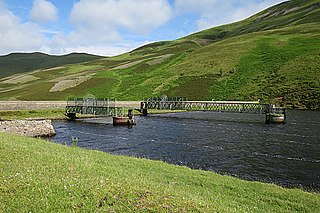
Edinburgh Water Company and its successors have provided a public water supply and latterly sewerage and sewage treatment services to the Scottish capital of Edinburgh since 1819. The original company was established to supply drinking water and did so until 1870, when it was taken over by a public Water Trust, with representatives from Edinburgh, Leith and Portobello. That in turn was taken over by Edinburgh Corporation and in 1975, responsibility passed to the Lothian Regional Council, as did the duty to provide sewerage and sewage treatment services. Both services were moved out of local authority control, and taken over by the East of Scotland Water Authority in 1996. The three Scottish regional water authorities were merged to form Scottish Water in 2002.
The Lanark Group is a late Silurian to early Devonian lithostratigraphic group in southern Scotland. The name is derived from the town of Lanark. It consists of sandstones and conglomerates within the Greywacke Conglomerate and Swanshaw Sandstone formations together with a wide range of igneous lithologies within the overlying Pentland Hills Volcanic Formation. The group is itself a division of the Old Red Sandstone Supergroup.

Caerketton Hill is a hill in the Pentland Hills range of Scotland. Standing at 478 m, it is at the northeast end of the approximately 25 km (16 mi) long chain of hills on the border between the council areas of the City of Edinburgh and Midlothian. The nearest town is Loanhead, 2 kilometers to the east while Edinburgh's southern suburbs start about a kilometer to the north. The nearest hills are Allermuir Hill to the west and Woodhouselee Hill to the south. The Swanston Burn and Lothian Burn rise on the northern slopes while the Boghall Burn receives water from the southern slopes. Their waters meet in the Burdiehouse Burn and, eventually, as the Brunstane Burn, drain into the Firth of Forth at Eastfield, Edinburgh.

Midlothian is a historic county of Scotland. It emerged in the Middle Ages as the territory surrounding the city of Edinburgh within the wider Lothian region, and was formally called the "shire of Edinburgh" or Edinburghshire until the 20th century. It bordered West Lothian (Linlithgowshire) to the west, Lanarkshire, Peeblesshire and Selkirkshire to the south, and East Lothian, Berwickshire and Roxburghshire to the east. Traditional industries included mining, agriculture and fishing, important towns outwith Edinburgh being Dalkeith, Musselburgh and Penicuik. Having always had a degree of autonomy over its own affairs since being made a county of itself in 1482, an Edinburgh City Corporation was formed in 1890, although it remained under Midlothian for some purposes. Conversely, the wider county was still administered within the city.







